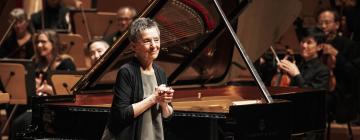Jeanette Tietze
I believe that music study is essential and can bring a person so much joy. It is a wonderful challenge and keeps us in touch with excellence.
I myself started piano lessons at age 7, and violin at 10. And I started the pipe organ at age 32 and study of the Kodaly Method of Music Education at age 43!
Singing is the most natural 'first instrument.' It encourages our musicality and expression, which we can then strive to emulate on our instruments. Listening to our tone is crucial to beautiful playing. I like to encourage my students in this direction.
